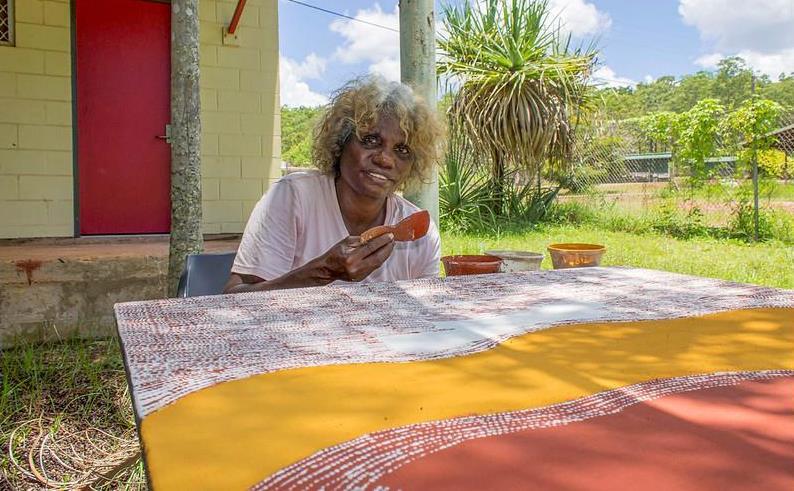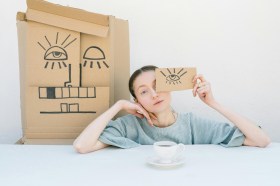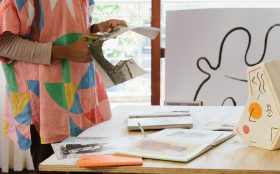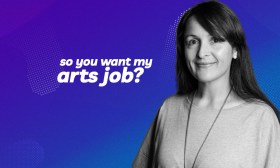Aboriginal culture dates back some 40,000 years, and yet it has had no difficulty pivoting online this year, with Darwin Aboriginal Art Fair (DAAF) more accessible and dynamic than ever before.
‘Art centres are used to having to communicate from a distance, so as an organisation we were well set up to work in isolation,’ Claire Summers, DAAF Foundation Executive Director, told ArtsHub.
Now in its 14th year, the 2020 DAAF program is set to run online for nine days from 6-14 August.
Expanded from a booth-style art fair usually held over four days, Summers said that being relieved from the pressure of venue hire and travel has allowed DAAF to offer an even broader audience experience of Indigenous art and culture in a safe space.
The fair is the flagship event of the not-for-profit organisation, Darwin Aboriginal Art Fair Foundation (DAAFF), which was formed in 2012 to promote the work of Aboriginal and Torres Strait Islander art centres in an ethical manner.
It has grown to include 70 arts centres in that time, all of which will be participating in this new digital offering.
Last year the fair generated $2.84M in art sales, and had a $13.2M impact on the Northern Territory economy. ‘Not having that physical visitation this year really hurts, but we are gearing the fair to build capacity and new audiences,’ said Summers.
What sets DAAF apart from many art fairs internationally, is that it takes no commissions on the artworks sold, with 100% of sales returning to the art centres and their artists.
This is especially prescient as our remote communities brace against the Coronavirus pandemic.
Summers explained: ‘As we went into lockdown, we called all our art centres and asked how they were doing. And, while everyone was facing a sobering situation, the resounding comment was that they needed to go online; they needed us to help them reach audiences to sell.’
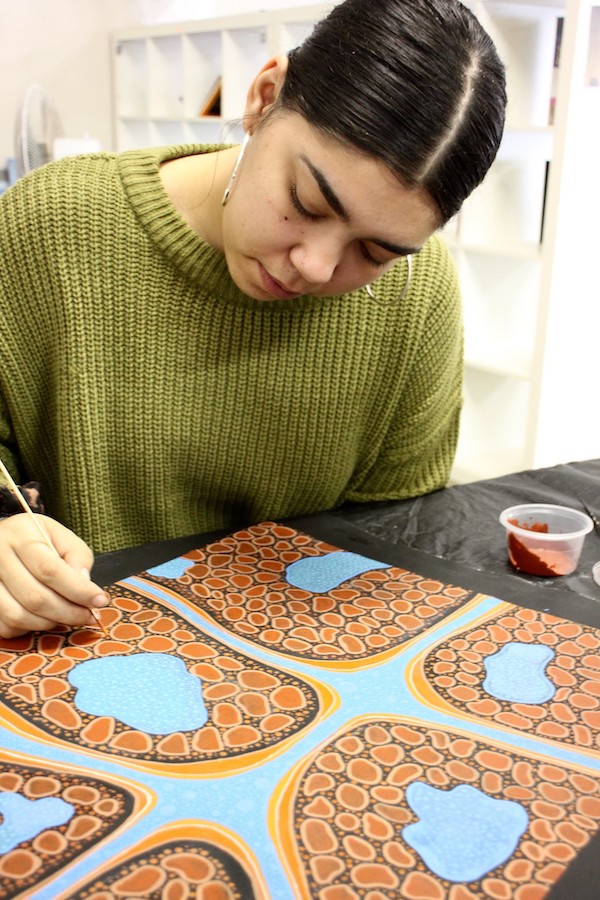
Lily-mae Kerley, Yamaji Art, 202. Photo courtesy of Yamaji Art.
How will it work?
With the rise of exhibition fly-throughs and virtual tours as our new reality, Summers was careful to make the distinction that DAAF Online was not a “virtual” fair experience.
‘You won’t have to spin your mouse and click through a space. It is going to be more like a gallery online. There will be the capacity to search, for example “bark painting”, and it will bring up bark paintings across all the art centres. Or you can visit any of our 68 participating art centres directly.’
Summers said that one of the big agendas for the digital pivot was to focus on cultural awareness.
‘You still need to bring that energy and buzz to the digital space that is the heart and soul of the physical fair. Every year it is an incredible meeting place of artists, curators and collectors.’
A big part of the online fair experience will be the Public Program, which will replicate that richness. From artists talking about their work, to masterclasses with an artist, and streamed cultural performance hosted on the DAAF website and social channels, ‘it is much more than just selling art,’ says Summers of 2020 DAAF.
New for the online edition is the Cultural Keepers Program – six sessions that will bring together Indigenous curators, art centre staff and international Indigenous guests in an exchange of stories and a ‘behind the scenes’ look into their world.
Supported by the Northern Territory Government, a further jewel of the program is the Inaugural National Indigenous Fashion Awards (NIFA), which will be broadcast on NITV and DAAF’s digital channels.
‘The energy and the growth of the Indigenous fashion movement has really taken off over the last few years, so the timing was right for an Award. There is so much skills development needed in this space,’ Summers added. Australian label Country Road is supporting the Award with a 12-month mentorship for the Fashion Design Award winner.

Shaun Namarnyilk & Owen Naborlhborlh on Injalak Hill. Photo: Kerri Meehan on behalf of Injalak Arts.
Addressing concerns of cyber security
Summers said that cyber security, image licensing and cultural IP protection have been major concerns for art centres taking the digital leap.
‘We needed our art centres to feel comfortable in this space,’ explained Summers. ‘Part of that process has been putting them through a cyber training course, which has covered everything from protecting their bank accounts, to protecting images against downloads.’
‘It’s not just about going digital for the fair; it is arming them to better protect their future,’ Summers told ArtsHub.
DAAF has sought advice from peak bodies, Arts Law Centre of Australia, Copyright Agency and the Indigenous Art Code to ensure all considerations were addressed.
‘I feel like we have run the marathon; now we have to do the sprint,’ said Summers. ‘It has been an amazing process to go through.’
Summers remains optimistic about DAAFs digital pivot. ‘I don’t think it is ever going to go away; I think there may be a digital component to our fair from now on.’
She also believes the investment in digitally upskilling will lead to greater financial stability for many art centres. ‘I see this as an opportunity to meet audiences and collectors that we have not been able to connect with before.’
‘Our art centres and artists have always curated their own spaces on the spot at the fair. We don’t have a glitzy catalogue to send to collectors who can’t attend to make purchases. So, it is very exciting to be able to address that this year, and even open up to an overseas market,’ she told ArtsHub.
‘I genuinely think people will support our First Nations artists. It may be a more philanthropic response this year. But I am also confident the digital space will introduce new buyers to the fair.
‘And, in light of the recent Black Lives Matter movement, it will allow us to reach out and give audiences a moment to connect. Art and fashion are a great conduit – it is not just purchasing – it is connecting with artists,’ Summers concluded.
To be part of DAAFs 2020 Art Fair and Public Programs be sure to put 6-14 August in your diary and virtually spend a little time on Country with our artists and their work.
